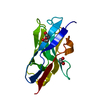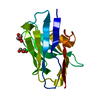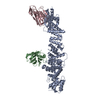+ Open data
Open data
- Basic information
Basic information
| Entry | Database: PDB / ID: 7zox | ||||||
|---|---|---|---|---|---|---|---|
| Title | Nup93 in complex with xhNup93-Nb4i and xNup93-Nb2t | ||||||
 Components Components |
| ||||||
 Keywords Keywords | NUCLEAR PROTEIN / NUP93 / Nuclearporin / inhibitory NB / tracking NB | ||||||
| Function / homology |  Function and homology information Function and homology informationnuclear pore complex assembly / structural constituent of nuclear pore / poly(A)+ mRNA export from nucleus / nuclear pore / nuclear periphery / protein import into nucleus / nuclear membrane / cytosol Similarity search - Function | ||||||
| Biological species |  | ||||||
| Method | ELECTRON MICROSCOPY / single particle reconstruction / cryo EM / Resolution: 4.4 Å | ||||||
 Authors Authors | Fu, Z. / Guttler, T. / Colom, M.S. | ||||||
| Funding support |  Germany, 1items Germany, 1items
| ||||||
 Citation Citation |  Journal: EMBO J / Year: 2024 Journal: EMBO J / Year: 2024Title: A checkpoint function for Nup98 in nuclear pore formation suggested by novel inhibitory nanobodies. Authors: Mireia Solà Colom / Zhenglin Fu / Philip Gunkel / Thomas Güttler / Sergei Trakhanov / Vasundara Srinivasan / Kathrin Gregor / Tino Pleiner / Dirk Görlich /   Abstract: Nuclear pore complex (NPC) biogenesis is a still enigmatic example of protein self-assembly. We now introduce several cross-reacting anti-Nup nanobodies for imaging intact nuclear pore complexes from ...Nuclear pore complex (NPC) biogenesis is a still enigmatic example of protein self-assembly. We now introduce several cross-reacting anti-Nup nanobodies for imaging intact nuclear pore complexes from frog to human. We also report a simplified assay that directly tracks postmitotic NPC assembly with added fluorophore-labeled anti-Nup nanobodies. During interphase, NPCs are inserted into a pre-existing nuclear envelope. Monitoring this process is challenging because newly assembled NPCs are indistinguishable from pre-existing ones. We overcame this problem by inserting Xenopus-derived NPCs into human nuclear envelopes and using frog-specific anti-Nup nanobodies for detection. We further asked whether anti-Nup nanobodies could serve as NPC assembly inhibitors. Using a selection strategy against conserved epitopes, we obtained anti-Nup93, Nup98, and Nup155 nanobodies that block Nup-Nup interfaces and arrest NPC assembly. We solved structures of nanobody-target complexes and identified roles for the Nup93 α-solenoid domain in recruiting Nup358 and the Nup214·88·62 complex, as well as for Nup155 and the Nup98 autoproteolytic domain in NPC scaffold assembly. The latter suggests a checkpoint linking pore formation to the assembly of the Nup98-dominated permeability barrier. | ||||||
| History |
|
- Structure visualization
Structure visualization
| Structure viewer | Molecule:  Molmil Molmil Jmol/JSmol Jmol/JSmol |
|---|
- Downloads & links
Downloads & links
- Download
Download
| PDBx/mmCIF format |  7zox.cif.gz 7zox.cif.gz | 162.5 KB | Display |  PDBx/mmCIF format PDBx/mmCIF format |
|---|---|---|---|---|
| PDB format |  pdb7zox.ent.gz pdb7zox.ent.gz | 125 KB | Display |  PDB format PDB format |
| PDBx/mmJSON format |  7zox.json.gz 7zox.json.gz | Tree view |  PDBx/mmJSON format PDBx/mmJSON format | |
| Others |  Other downloads Other downloads |
-Validation report
| Summary document |  7zox_validation.pdf.gz 7zox_validation.pdf.gz | 374.4 KB | Display |  wwPDB validaton report wwPDB validaton report |
|---|---|---|---|---|
| Full document |  7zox_full_validation.pdf.gz 7zox_full_validation.pdf.gz | 391.6 KB | Display | |
| Data in XML |  7zox_validation.xml.gz 7zox_validation.xml.gz | 19.2 KB | Display | |
| Data in CIF |  7zox_validation.cif.gz 7zox_validation.cif.gz | 28.8 KB | Display | |
| Arichive directory |  https://data.pdbj.org/pub/pdb/validation_reports/zo/7zox https://data.pdbj.org/pub/pdb/validation_reports/zo/7zox ftp://data.pdbj.org/pub/pdb/validation_reports/zo/7zox ftp://data.pdbj.org/pub/pdb/validation_reports/zo/7zox | HTTPS FTP |
-Related structure data
| Related structure data |  14849MC  7nowC  7nqaC  8cdsC  8cdtC  8ozbC M: map data used to model this data C: citing same article ( |
|---|---|
| Similar structure data | Similarity search - Function & homology  F&H Search F&H Search |
- Links
Links
- Assembly
Assembly
| Deposited unit | 
|
|---|---|
| 1 |
|
- Components
Components
| #1: Protein | Mass: 74782.289 Da / Num. of mol.: 1 Source method: isolated from a genetically manipulated source Details: Xenopus laevis Nup93(residues 168-820) / Source: (gene. exp.)  |
|---|---|
| #2: Antibody | Mass: 13811.384 Da / Num. of mol.: 1 Source method: isolated from a genetically manipulated source Details: 5-Nup93 inhibitory NB / Source: (gene. exp.)   |
| #3: Antibody | Mass: 12921.641 Da / Num. of mol.: 1 Source method: isolated from a genetically manipulated source Details: 15-Nup93 tracking NB / Source: (gene. exp.)   |
-Experimental details
-Experiment
| Experiment | Method: ELECTRON MICROSCOPY |
|---|---|
| EM experiment | Aggregation state: PARTICLE / 3D reconstruction method: single particle reconstruction |
- Sample preparation
Sample preparation
| Component | Name: Nup93 in complex with 5-Nup93 inhibitory NB and 15-Nup93 tracking NB Type: COMPLEX / Entity ID: all / Source: RECOMBINANT | ||||||||||||||||||||
|---|---|---|---|---|---|---|---|---|---|---|---|---|---|---|---|---|---|---|---|---|---|
| Molecular weight | Value: 0.1 MDa / Experimental value: NO | ||||||||||||||||||||
| Source (natural) | Organism: Xenopus laevis, Vicugna pacos | ||||||||||||||||||||
| Source (recombinant) | Organism:  | ||||||||||||||||||||
| Buffer solution | pH: 7.5 | ||||||||||||||||||||
| Buffer component |
| ||||||||||||||||||||
| Specimen | Conc.: 1 mg/ml / Embedding applied: NO / Shadowing applied: NO / Staining applied: NO / Vitrification applied: YES Details: The complex was further purified by size exclusion chromatography using a HiLoad 26/60 Superdex 200 column. The purified complex was applied to a glow-discharged grid after being diluted to 1 mg/ml. | ||||||||||||||||||||
| Specimen support | Grid material: COPPER / Grid mesh size: 300 divisions/in. / Grid type: Quantifoil R2/2 | ||||||||||||||||||||
| Vitrification | Instrument: FEI VITROBOT MARK IV / Cryogen name: ETHANE / Humidity: 100 % / Chamber temperature: 277.15 K Details: Sample volume: 2.0 microliters blotting time: 5 s blot force setting: 6 |
- Electron microscopy imaging
Electron microscopy imaging
| Experimental equipment |  Model: Titan Krios / Image courtesy: FEI Company |
|---|---|
| Microscopy | Model: FEI TITAN KRIOS |
| Electron gun | Electron source:  FIELD EMISSION GUN / Accelerating voltage: 300 kV / Illumination mode: FLOOD BEAM FIELD EMISSION GUN / Accelerating voltage: 300 kV / Illumination mode: FLOOD BEAM |
| Electron lens | Mode: BRIGHT FIELD / Nominal magnification: 81000 X / Nominal defocus max: 2500 nm / Nominal defocus min: 1500 nm / Cs: 2.7 mm / C2 aperture diameter: 50 µm |
| Specimen holder | Cryogen: NITROGEN / Specimen holder model: FEI TITAN KRIOS AUTOGRID HOLDER |
| Image recording | Average exposure time: 2 sec. / Electron dose: 54 e/Å2 / Film or detector model: GATAN K3 (6k x 4k) / Num. of grids imaged: 1 / Num. of real images: 12320 / Details: Counting mode 5 images per hole( beam-image shift) |
| EM imaging optics | Energyfilter name: GIF Quantum LS / Energyfilter slit width: 20 eV |
| Image scans | Width: 5760 / Height: 4092 |
- Processing
Processing
| EM software |
| ||||||||||||||||||||||||
|---|---|---|---|---|---|---|---|---|---|---|---|---|---|---|---|---|---|---|---|---|---|---|---|---|---|
| CTF correction | Type: PHASE FLIPPING AND AMPLITUDE CORRECTION | ||||||||||||||||||||||||
| Particle selection | Num. of particles selected: 808840 | ||||||||||||||||||||||||
| Symmetry | Point symmetry: C1 (asymmetric) | ||||||||||||||||||||||||
| 3D reconstruction | Resolution: 4.4 Å / Resolution method: FSC 0.143 CUT-OFF / Num. of particles: 202725 / Symmetry type: POINT |
 Movie
Movie Controller
Controller



 PDBj
PDBj


